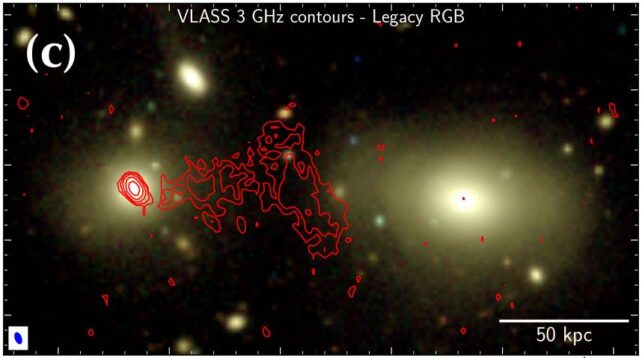We don't know what a galaxy named RAD12-B did, but it must have been something heinous.
That's because its companion galaxy has blasted a hot plasma jet right at it, in what seems (if we're going to be anthropomorphic about it) like a targeted attack.
Discovered during observations by a team led by astronomer Ananda Hota of the University of Mumbai in India, this is the sixth ever galaxy pair found engaging in this sort of plasma-blasting activity. But the RAD12 system is unique for several reasons, and astronomers aren't sure why.
For one thing, it's the first time we've seen a galaxy firing a plasma jet at a galaxy that's bigger than it is.
For another, there's only one jet. We've seen many, many galaxies blasting jets of plasma into space, and typically these jets come in pairs. Why RAD12 only has one is a mystery.
High-speed plasma jets emitting radiation in radio wavelengths are somewhat common in the Universe. They're known as radio galaxies, and the jets are emitted by the galactic nucleus. Scientists believe that the supermassive black hole at the galaxy's center is responsible.
Galactic supermassive black holes are often surrounded by vast amounts of material, which swirls around in a disk and falls onto the black hole from the disk's inner rim. This accretion process is messy, though; not all the material from the inner edge of the disk makes its way beyond the event horizon.

Some of it gets diverted and accelerated along the magnetic field lines around the outside of the black hole. It's whisked away to the black hole's poles, where it is launched into space at speeds close to that of light in a vacuum, punching vast distances through the intergalactic medium, acting as a synchrotron to accelerate electrons that then emit radio waves.
There's a lot about this process we still don't understand, but it's typically seen in elliptical galaxies – those that are sort of fuzzy, formless blobs, as opposed to the highly structured forms of spiral galaxies. Elliptical galaxies don't tend to have a lot of star formation going on; most of the stars within them are old, and they don't contain as much star-forming material. The jets are thought to play a role in this, providing "feedback" that quenches star formation.
The RAD12 system might be able to help astronomers understand these processes, since outliers put constraints on what certain classes of object can and can't do. In addition, the rare galaxy systems in which the jet of one slams into the other can showcase positive feedback, in which the galaxy being bombarded shows signs of positive feedback, or heightened star formation activity.
Scientists have known that there was something unusual about RAD12, located around a billion light-years away, since the 1990s, but it wasn't until a citizen science project to analyze data collected using the Giant Meterwave Radio Telescope (GMRT) in India called RAD@home that the full extent of its oddness was revealed.

The two galaxies in the system are in the process of merging, their two nuclei separated by a distance of 414,000 light-years. Together, the entire structure is 440,000 light-years long, much larger than the jet's host galaxy (although it's not unusual for radio jets to exceed in length the diameter of their host galaxy).
This means that the jet is slamming into RAD12-B, but unlike the five other galaxy systems of this kind, RAD12-B shows no signs of positive feedback, i.e., heightened star formation activity.
And the host galaxy's single jet is a real puzzle. It's possible that something may have prevented its escape, such as "shells" of stars around the galaxy created by a past merger that have trapped the interstellar medium and resulted in regions of higher density. We've also seen cases where radio jets are bent and diverted by powerful magnetic fields in space.
Figuring out exactly what is going on with RAD12 is going to take more work, including observations with multiple telescopes, but it promises to be a fascinating case indeed.
The research was published in the Monthly Notices of the Royal Astronomical Society last year, and has been accepted for publication in The Multimessenger Chakra of Blazar Jets: Proceedings of the 375th Symposium of the International Astronomical Union.
